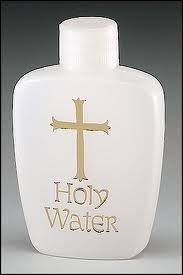In Anglicanism, Catholicism, Eastern Orthodoxy, Lutheranism, Oriental Orthodoxy, and some other churches, holy water is water which has been sanctified by a priest for the purpose of baptism, the blessing of persons, places, and objects; or as a means of repelling evil.
The first use of holy water, i.e. for baptism and spiritual cleansing, is common among several religions, from Christianity to Sikhism and Hinduism.
The second use of holy water, i.e. as a sacramental for protection against evil, is almost exclusive to Roman Catholics.
The use of holy water in the earliest days of Christianity is attested to only in somewhat later documents. The Apostolic constitutions which go back to about the year 400, attribute to the precept of using holy water to Apostle Matthew. Hence the first historical testimony goes back to the fifth century. However, it is plausible that, in the earliest Christian times, water was used for expiatory and purificatory purposes, to a way analogous to its employment under the Jewish Law. Yet, in many cases, the water used for the Sacrament of Baptism was flowing water, sea or river water, and it could not receive the same blessing as that contained in the baptisteries.
Holy water is used as a sacramental in the baptismal ceremony.
Holy water is kept in the font, the church furnishing used for baptisms, which is typically located at the entrance to the church (or sometimes in a separate room or building called a baptistery); its location at the entrance serves as a reminder of the centrality of baptism as the primary rite of initiation into the Christian faith. Smaller vessels, called stoups, are usually placed at the entrances of the church. As a reminder of baptism, Catholics dip their fingers in the holy water and make the sign of the cross when entering the church. The liturgy may begin on Sundays with the Rite of Blessing and Sprinkling Holy Water, in which holy water is sprinkled upon the congregation; this is called aspersion, from the Latin, asperges ("to sprinkle"). This ceremony dates back to the ninth century. An aspergill or aspergillum is a brush or branch used to sprinkle the water. An aspersorium is the vessel which holds the holy water and into which the aspergillum is dipped, though elaborate Ottonian examples are known as situlae. Blessed salt may be added to the water "where it is customary."
In Christianity, asperges is the name given to the rite of sprinkling a congregation with holy water. The name comes from the first word in the 9th verse of Psalm 51 in the Latin translation, the Vulgate, which is sung during the Traditional form of the rite, except during Eastertide.


